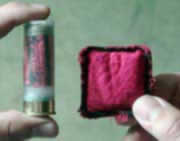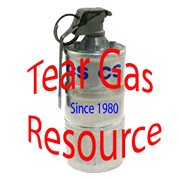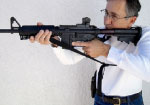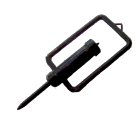A university student who lost an eye after being injured during a riot was shot in the head by police with a bag of lead, authorities confirmed. The Assistant Police Chief said he didn't know how Jeff Smith, 19, came to be shot in the head during the Tucson riot following the University of Arizona's loss in the NCAA championship on April 2, 2001. He said officers are trained to aim for the legs when using the ammunition, called "beanbags." "We would not try and fire  at locations of the body where it could cause severe injury," he said. At least two people received head injuries from what police referred to as "nonlethal weapons" during the riot. (Dateline: Tucson - 4/10/2001)
at locations of the body where it could cause severe injury," he said. At least two people received head injuries from what police referred to as "nonlethal weapons" during the riot. (Dateline: Tucson - 4/10/2001)
Should officers use less-lethal munitions if they are facing a suspect, armed with a knife, rock, board, tree branch or rake who is further than 21 feet away? Should officers use less-lethal munition to subdue unarmed protestors who are merely refusing dispersal orders, or subdue an unarmed suspect requesting police to shoot them? Although each situation described above has to be viewed on its own merits a few general concepts are used to judge the appropriateness of this type of use of force.
The differences between less-lethal and nonlethal have been blurred over our zealousness to use less force in taking suspects in custody. Many years ago less-lethal munitions were used in situations where lethal force was justified and we wanted to try and use less force in the hope we could save the suspect’s life. Those agencies employing less-lethal were very successful in their usages. Although some suspects were killed from the less-lethal munitions they were suspects that the officers could have justifiably used lethal force on. Not many people complained because they understood that the officers were trying to save the suspects life by using those specialty munitions.
Because we have been so successful in reducing death using less-lethal force in those situations where lethal force could have been justifiable employed we have started using less-lethal munitions in situations where lethal force was not justified. These uses are leading to more and more serious injuries and litigation where we are the defendants.
Another incident is described  in a newspaper article from the Tennessean. “A beanbag bullet, 40 grams of buckshot gathered into a sock like pouch and fired from a 12-gauge shotgun, is meant to immobilize, not kill. On Saturday night, however, such a projectile killed a Franklin County man, prompting a review by the Tennessee Bureau of Investigation and raising questions about the safety of the beanbag, a popular munitions alternative used by many Tennessee law officers. “We don't know why it happened. All we can say at this point is that it was a freak accident," said Capt. Tim Fuller of the Franklin County Sheriff's Department.”
in a newspaper article from the Tennessean. “A beanbag bullet, 40 grams of buckshot gathered into a sock like pouch and fired from a 12-gauge shotgun, is meant to immobilize, not kill. On Saturday night, however, such a projectile killed a Franklin County man, prompting a review by the Tennessee Bureau of Investigation and raising questions about the safety of the beanbag, a popular munitions alternative used by many Tennessee law officers. “We don't know why it happened. All we can say at this point is that it was a freak accident," said Capt. Tim Fuller of the Franklin County Sheriff's Department.”
In a case from Central California a deputy sheriff shot a mentally disturbed individual walking towards him at a distance of 30 feet with a bean bag round. The suspect was armed with a can of lighter fluid but no ignition source. The suspect had complied with all prior directions given by the deputies. He was screaming at the deputy. The deputy gave no warning that he was going to shoot the suspect. The beanbag hit the suspect in his eye. The force of the bag damaged the eye resulting in the suspect losing that eye.
The United States Ninth Circuit Court of Appeals concluded in Deorle V. Rutherford 99-17188 1 that:
”Viewing the facts in the light we must, we conclude that, for purposes of summary judgment, Rutherford’s use of force was excessive and the defense of qualified immunity is unavailing. At a distance of 30 feet, Rutherford shot at a man who would have been better placed in a hospital than in custody. The degree of force was  clearly in excess of the governmental interest at stake, and was used in circumstances that did not justify the failure to warn. There was no basis for any factual misperception and no reasonable officer could have concluded that the force employed was constitutional.”
clearly in excess of the governmental interest at stake, and was used in circumstances that did not justify the failure to warn. There was no basis for any factual misperception and no reasonable officer could have concluded that the force employed was constitutional.”
The term less-lethal is generally used to define a weapon or ammunition that may cause serious injury or death even when properly deployed, but is designed to not cause death if deployed within the manufacturers guidelines. It is generally accepted that these types of tools will cause injury resulting, at a minimum, in an emergency room visit.
The term nonlethal is generally defined as a weapon, chemical or ammunition that will not cause serious injury and/or death when deployed properly. It may cause welts or eye watering but generally won’t require an emergency room visit.
Law enforcement has blurred the distinction between less-lethal and nonlethal force. They have degraded the meaning of less-lethal force options to the point that we are using tools that are likely to cause serious injury and/or death in situations that call for far less force. Many agencies have written into policy that beanbag rounds are to be used as “extended range batons”. Many less-lethal manufacturers have advertised that their products, beanbags,2 stingballs, etc. should be used for riot control or crowd control. For the most part these are nonlethal situations. The term beanbag has helped foster the misunderstanding. It makes you think that the bags are filled with beans. In fact the bags are generally filled with lead shot. If a bag breaks we are hurtling lead shot a 280-300+ feet per second towards a suspect. At these speeds and size of the lead shot the kinetic energy will penetrate the human body.

When making an arrest law enforcement officers can only use that force which is reasonable and necessary for the totality of the circumstances they are faced with. Officers must stop the illegal actions of suspects as quickly as possible using the least amount of force necessary to control the situation. Officers and managers would like the minimum force used in all incidents. However, this is hard to do when they start out with misconceptions about the level of force their tools deliver.
How do we measure and know what is the least amount of force? Force must be measured by the amount of injury that it does to the suspect, the officer and any uninvolved persons in the area. Every department should develop a matrix of force based on their department’s experience with all their force alternatives available to them, coupled with the regional and national uses of the same alternatives. As a responsible individual they should make sure that all force used is reviewed and meets the standard that it was reasonable and necessary for the circumstances in which it was used.
How can we morally and /or legally justify using force that is likely to produce serious injury or death against a crowd of people that are trying to exercise their first amendment rights? How can we morally and/or legally justify using force that is likely to produce serious injury or death against persons that are not in a position to injure us or someone else? How can we morally justify using force likely to cause serious injury or death against persons that are doing no more than watching someone else participate in civil disobedience? The answer is we can’t!
If you do nothing else as a result of this article review your use of force policies and make sure that you haven’t blurred the distinction between less-lethal and nonlethal force options. Your chemical agents are generally considered to be a non-lethal force option. That said the 9th Circuit of appeals has said even your chemical agents must be considered an intermediate force option. Increase your available tools so your officers and deputies have both nonlethal and less-lethal options available to them. Having less-lethal and nonlethal alternatives doesn’t do the officer any good if the tools he needs is in a sergeant’s car or with a SWAT team. Less-lethal and nonlethal tools need to be available to not only SWAT but also the patrol officer. The patrol officer when faced with a man with a board, brick, knife, etc. needs the tools available to him immediately. top
Beanbag rounds are projectiles enclosed in a heavy Cordura nylon and filled with pellets that can travel at 280 feet per second. They have a very high potential for injury and death and are not accurate. The effective range is 50 feet. To reduce the possibility of serious injury or death, the following standards of employment are recommended: At distances of less than 10 feet, extreme caution should be exercised prior to deployment due to high possibility of fatal outcome. At distances of ten to twenty feet, avoid the head, neck, spleen, liver and kidney areas. (back)





